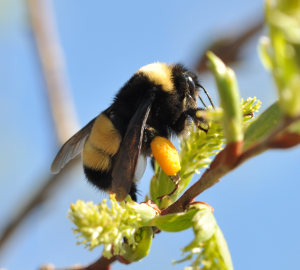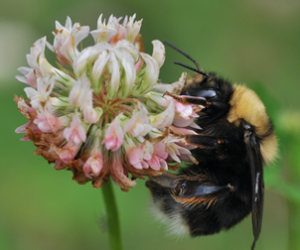Pollinator conservation management for climate change in British Columbia
Categories:
Happy Pollinator Week!
Pollinators come in all shapes and sizes and are important for ecosystem functioning around the world. Protected areas, like those that BC Parks takes care of, let scientists collect data that help us understand the baseline conditions for comparison as we cope with climate change impacts on both protected and unprotected areas.

The BC Parks Living Lab Program, funded by the BC Parks Licence Plate Program, supported Simon Fraser University (SFU) to study pollinators in our changing climate. SFU researchers wanted to know: how do pollinators move through landscapes impacted by fire? Can this information be used to manage wildfires in a way that is most supportive for pollinator needs? If pollinators’ needs are supported, then plants’ needs are supported and these are foundational elements of every functional habitat and ecosystem. Bumble bees have some cool characteristics that make them important and unique pollinators in B.C, and particularly useful for our research questions.
Did you know?

- Bumble bees are all similar – you might not even have known that there is more than one kind of bumble bee! In fact, there are about 250 species in the world, and B.C. is home to ~35 of them. Different species differ subtly in their size, flower preferences, etc. More than 14 species are present at our study location in Tweedsmuir Provincial Park South, including two Canadian species-at-risk, the yellow-banded (Bombus terricola) and the western bumble bee (Bombus occidentalis). Comparing species that are similar but different in specific ways can let scientists pinpoint what exactly it is about different pollinators that impacts their experience of a landscape the most, especially important for declining species.
- Bumble bees have a unique annual life cycle. Queens are true matriarchs and key for reproduction, and they are the only ones that live the entire year. In the spring, queens emerge from hibernation searching for food and a place to nest. She will lay eggs to produce workers, and they soon take over feeding the colony while the queen remains in the nest. Workers don’t reproduce; therefore, scientists focus on collecting them for research doing our best to minimize negative impacts on the populations.
- Bumble bees (and some other social insects) have a unique genetic structure called haplodiploidy that helps stabilize the colony. With humans, you’re related about the same amount to your siblings vs. your children – you share ~50% of your genes. With bumble bees, workers are more related to their sisters than to their hypothetical daughters, and so there is extra incentive for them to support the colony instead of laying their own eggs.
- This genetic structure can be used to map the locations of sets of sisters (75% related) across a landscape. How many sets of sisters (numbers of colonies) of each bumble bee species are there in the forest area sampled? In the burn area? Different distances from the edge of the burn area? How far apart are sets of sisters (foraging distance) of the same/different species in the different habitats? Are there “forest” species and “fire” species?
Last summer, SFU researchers set up a project on Nuxalk and Ulkatcho territories in Tweedsmuir Provincial Park South. They established a 90-site grid of bee traps across and along the edge of an area extensively burned after a lightning strike in 2017. The spaces between sites differed based on all the distances bumble bees tend to travel, according to previous research. Travel distance can vary based on a lot of different factors, such as habitat, location, species, and season.

The researchers are processing the genetic information from the sampled workers and look forward to learning more about how far bumble bees fly in forests impacted by wildfire.
This project was funded in part by the BC Parks Living Lab Program, which is funded by the BC Parks’ Licence Plate Program. The Program promotes the province’s protected areas as places to learn about the impacts of climate change, how to mitigate and manage those impacts, and share information between academics and practitioners.
Learn More: For more information on the Living Lab Program and the criteria for funding applications, visit: http://www.env.gov.bc.ca/bcparks/partnerships/living-labs/




